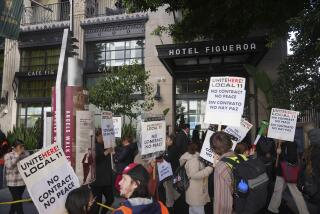There’s Bad and Good for Tourists in Hawaii Trends
- Share via
“Look for the phrase ‘poised for growth,’ ” a wise business reporter once told me, “and behind it you will almost surely find a troubled enterprise.”
Now hear this: Hawaii has been poised for growth for several years now.
Since the mid-1990s, the state and its tourism industry have been struggling with falling or flat visitor-arrival numbers. There are some encouraging signs, including an 8% increase in U.S. tourists during the first seven months of this year, but these have been lean years in the islands. The consequences for travelers: some probable bad news, then some good news, then more bad news.
The probable bad news: After three years of fierce price competition between two leading operators of tours to Hawaii, the younger company has reduced its efforts in Southern California.
The apparent winner in this battle is Pleasant Hawaiian Holidays, telephone (800) 7-HAWAII (742-9244), Internet https://www.2hawaii.com, veteran of four decades of offering Hawaii packages from LAX year-round. Typical packages include a flight on its partner airline, American Trans Air, and seven nights in a hotel room for as little as $484 per person, double occupancy. (To get those low-end rates, consumers generally have to travel on weekdays, avoid periods of peak demand like the summer, and stay in spartan hotels.)
As competition and the U.S. economy have waxed and waned, Pleasant Hawaiian’s prices for a seven-day trip have followed. They were $329 in 1983 (glory days for the Hawaiian tourist trade) and $299 in 1992 (after the Gulf War and a U.S. economic slump depressed the travel industry worldwide). The tariff was $399 in 1997, the year San Jose-based Sunquest/SunTrips decided to challenge Pleasant Hawaiian in California. By 1999, the competition was still raging, and Pleasant Hawaiian’s low-end, seven-day air-land package price was just $385.
Sunquest/SunTrips, a subsidiary of British-based travel conglomerate Airtours, took aim at budget travelers, offering charter flights to Hawaii from Los Angeles and the San Francisco Bay area. At first, Sunquest operated the trips from LAX, and sister company SunTrips operated from San Francisco. But in August, SunTrips, tel. (800) SUN-TRIPS (357-2400), Internet https://www.suntrips.com, took over all trips to Hawaii from California, a spokeswoman said.
SunTrips vows to match any competitor’s price, and its off-season seven-day packages fell as low as $419 in early 2000. Even during the peak season, SunTrips’ rates were as low as $549 for a week. But on Aug. 31, SunTrips put a seasonal stop to its LAX-Hawaii flights. Instead of flying year-round, SunTrips will cover that route only from April through August.
Will reduced competition bring higher prices? It may have already. Pleasant Hawaiian spokesman Ken Phillips notes that many factors go into setting package rates, especially fuel-related fluctuation of air fares. But the bottom line is that this year’s best price for a Pleasant Hawaiian seven-day package is $484, nearly $100 higher than last year’s. (Pleasant Hawaiian’s bottom price for air fare only remains what it was in 1997: $229, if you can meet the many restrictions.)
As for the year ahead, “We’ll see some increase, probably in the single-digit [percentage] area, for next year,” Phillips said.
Now some good news: Reports indicate the islands are as beautiful as ever. In fact, the island landscape is largely unchanged in the last five years because economic doldrums have brought construction of hotels and other large ventures to a near standstill.
The economic slump stems from the downturn of the Japanese economy in the late 1990s. Hawaii’s dependence on visitors from Asia is so great that in many ways Hawaii, especially Honolulu, has been standing still economically while the rest of the U.S. has been thriving. That’s bad for Hawaii, of course, but good for anybody headed there and hoping for bargains.
In its most recent calculation of daily expenses that the typical business traveler faces, the Wisconsin-based research firm Runz-heimer International found that visitor spending per day in Honolulu had fallen from $236 in 1994 to $194 in 1996, then to $188 in April 2000. (The figure represents three restaurant meals and a night in a business-class hotel.)
Meanwhile, as costs on the ground for travelers in Honolulu were falling 3% since 1996, they were rising 16% in San Francisco to $283, and increasing 39% in San Diego to $231.
Hotel industry figures for Oahu send the same message. The Bank of Hawaii’s 1999 annual economic report notes that from 1996 to 1999, Oahu hotel occupancy dipped from 82% to 73% and the average room rate climbed only $2, to $119.
How big a role do the missing Japanese play? The bank report noted that “‘westbound visitors”--that is, visitors from Japan and the rest of Asia--decreased by 5.9% from 1998 to 1999. Arrivals from North America and Europe, meanwhile, increased by 6.1%. But that doesn’t balance the scales, because the typical Japanese visitor spends $225 daily, compared with $128 to $159 for visitors from the mainland, state figures show.
And more bad news: The affordability of Oahu is only part of the story. Oahu has about half the state’s hotel rooms. Other islands have been doing better, thanks largely to more nonstop flights from mainland cities.
On the Big Island of Hawaii, especially, prices for the luxury hotels along the Kona coast have been steadily increasing. The average Big Island hotel tab rose from $128 to $166 last year.
On Maui, the same researchers found, the average hotel rate rose from $151 to $167. Kauai’s average rate increased from $137 to $160.
Certainly, Californians never stopped thinking about Hawaii. About 1.36 million of us visited the islands last year. But other regions have been showing more enthusiasm than ours. In 1999, travel to Hawaii was up 10.3% from the East Coast, 6.8% from Texas, 16% from Oregon, 10.2% from Washington state. It was up 2.4% from California.
*
Christopher Reynolds welcomes comments and suggestions, but cannot respond individually to letters and calls. Write Travel Insider, Los Angeles Times, 202 W. 1st St., Los Angeles, CA 90012 or e-mail [email protected].
More to Read
Sign up for The Wild
We’ll help you find the best places to hike, bike and run, as well as the perfect silent spots for meditation and yoga.
You may occasionally receive promotional content from the Los Angeles Times.







